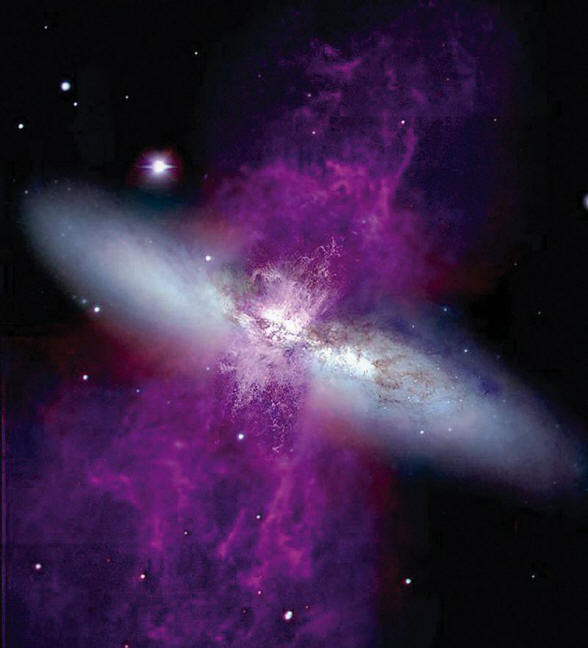|
|
Where the Star Winds Blow
Nov 11, 2009
Radial filaments within galactic
"superwinds" identify them as plasma
phenomena.
“If a man does not know what port he
is steering for, no wind is
favorable to him.”
--- Seneca
The irregular galaxy M82—otherwise
known as the Cigar Galaxy—forms a
pair with M81, Barnard's Galaxy in
the constellation Ursa Major. M82 is
also referred to as a "starburst
galaxy," because it is thought to
form new stars at a rate 10 times
greater than the Milky Way. Rapid
star formation is said to have
dramatically affected M82. So called
"stellar winds" from new stars and
the shock waves from supernovae have
caused hot hydrogen and nitrogen
(with temperatures more than 10
million Kelvin) to fan out from the
galactic core for several thousand
light years.
A recent press release from the
Chandra X-ray Telescope identifies
the superheated gases as a galactic
"super wind."
According to the tenets of Electric
Universe theory,
galactic evolution can be
explained in terms of large-scale
plasma discharges that form spinning
wheels of coherent filaments. Stars
in galaxies tend to coalesce in long
arcs like beads on a string, one of
a hundred mysteries that
conventional cosmology must
confront. No gravity-only theory can
explain star formation, in general,
but the barred spirals and the
tremendous elliptical whirlpools
that congregate in
million-light-year clusters are
beyond any conventional definition.
When plasma moves through a dust or
gas, the cloud becomes ionized and
electric currents flow. When
electricity pushes through any
substance it forms a magnetic field.
One aspect of magnetism in plasma is
that it creates what are sometimes
called “plasma
ropes.” Magnetic fields surround
the plasma, confining it into a
coherent system known as a Birkeland
current.
Birkeland currents are ionic
filaments that transport charge
great distances through space along
their tubular interiors. The tubes
are really double-walled, folded
layers of
charge separation that isolate
the regions of opposite charge,
keeping them from neutralizing each
other.
In previous Picture of the Day
articles, we noted that many
structures in the Universe are
active energy sources, such as
M82. Such galaxies are often
observed to eject charged matter
from their poles. Plasma
cosmologists have long known that
the ionic lobes extending far above
the poles of "radio" galaxies are
the signature of Birkeland currents.
Almost every body in the Universe
displays some kind of filamentation.
Comet tails are often in pairs, one
dusty and one composed of "stringy"
ion filaments. Planetary nebulae
resolve into intricate webs.
Herbig-Haro stars and energetic
galaxies emit jets that resolve into
braids. The spiral arms of some
galaxies look "hairy" with threads
of material extending from them.
Every element in a galactic circuit
radiates energy, and it must be
powered by its coupling with larger
circuits. The extent of those larger
circuits is indicated by the
observation that
galaxies occur in strings.
Written by Stephen Smith from an
idea suggested by Jim Johnson
|
|
|
|
|
|
SPECIAL NOTE - **New Volumes Available:
We are pleased to announce a new
e-book series
THE UNIVERSE ELECTRIC. Available now, the first volume
of this series, titled Big Bang, summarizes the failure of modern cosmology
and offers a new electrical perspective on the cosmos. At
over 200 pages, and
designed for broadest public appeal, it combines spectacular
full-color graphics with lean and readily understandable
text.
**Then second and third volumes in the series are now available,
respectively titled Sun and Comet, they offer
the reader easy to understand explanations of how and why these bodies
exist within an Electric Universe.
High school and college students--and teachers in
numerous fields--will love these books. So will a large
audience of general readers.
Visitors to the Thunderbolts.info site have often
wondered whether they could fully appreciate the Electric
Universe without further formal education. The answer is
given by these exquisitely designed books. Readers from
virtually all backgrounds and education levels will find them
easy to comprehend, from start to finish.
For the Thunderbolts Project, this series is a milestone.
Please see for yourself by checking out the new
Thunderbolts Project website, our leading edge in
reaching new markets globally.
Please visit our
Forum
|
|
|
|
|
|
|
|







